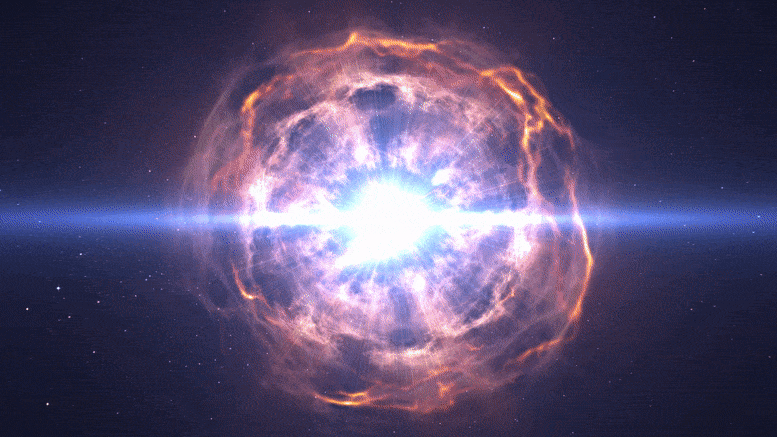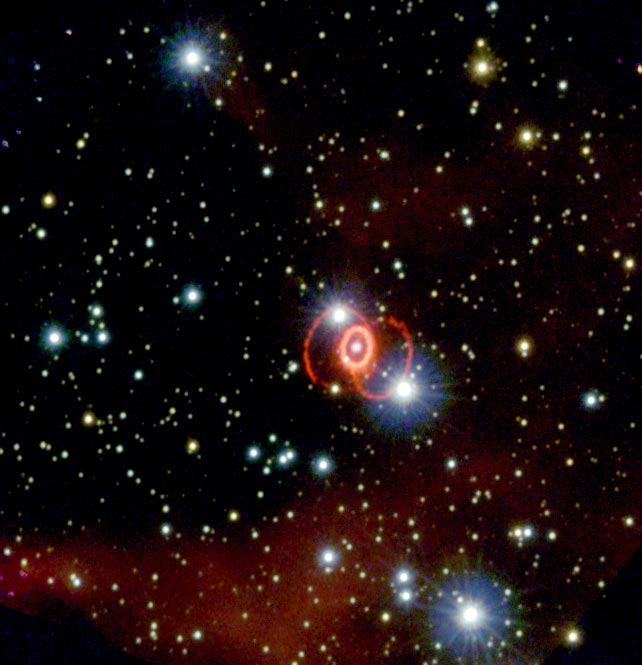
Artist’s impression of two white dwarf stars merging and creating a Type Ia supernova. Credit: ESO/L. Calçada
What Is a Supernova?
Supernovae are dramatic explosions that take place during the final stages of the death of a supermassive star.
Most stages of astronomical evolution happen over timescales far longer than a human lifetime, and even far longer than humanity’s entire history. Supernova explosions are spectacular exceptions to that rule. Several different pathways can lead to a supernova explosion, one of which is the death of a supermassive star. After a supermassive star has begun to die, it goes through various stages of fusing different elements, forming a red supergiant. During this process, more and more heavy material is deposited onto the stellar core. Once the core’s mass tips past a certain threshold it collapses under its own gravity. As the core collapses, the outer layers are blasted outwards in a supernova, the biggest explosion known to occur in the Universe. At its peak, a supernova can be brighter than an entire galaxy and can reach a diameter several light-years across. Supernovae reach their peak luminosity in a matter of days, so their appearance and early decline can very much be observed in real-time — in fact, some supernova events were first detected by amateur astronomers.
Hubble’s sharp vision means that it can see supernovae that are billions of light years away and difficult for other telescopes to study. A supernova image from the ground usually blends in with the image of its host galaxy. Hubble can distinguish the light from the two sources and thus measure the supernova directly.
Supernovae are dramatic explosions that take place during the final stages of the death of a supermassive star. Credit: ESA/Hubble (L. Calçada)
The top scientific justification for building Hubble was to determine the size and age of the Universe from observations of Cepheid variables in distant galaxies. Cepheids are a special type of variable star with very stable and predictable brightness variations. This means that astronomers, just by looking at the variability of their light, can find out about the Cepheids’ physical nature, which then can be used very effectively to determine their distance. For this reason cosmologists call Cepheids ‘standard candles’. Astronomers have used Hubble to observe Cepheids with extraordinary results, and they have then been used as stepping-stones to make distance measurements to supernovae, which have, in turn, provided a measure of the scale of the Universe. Today we know the age of the Universe to a much higher precision than before Hubble: around 13.7 billion years.
One of Hubble’s initial ‘core’ purposes was to determine the rate of expansion of the Universe, known to astronomers as the Hubble Constant. After eight years of Cepheid observations this work concluded by finding that the rate of expansion is increasing. Hubble’s sharp vision means that it can see supernovae that are billions of light years away and difficult for other telescopes to study. A supernova image from the ground usually blends in with the image of its host galaxy. Hubble can distinguish the light from the two sources and thus measure the supernova directly.
From Hubble’s supernova results, it seems clear that the expansion is nowhere near slowing down. In fact, due to some mysterious property of space itself, called dark energy, is causing the expansion to accelerate and this will continue forever. This surprising conclusion came from combined measurements of remote supernovae with most of the world’s top-class telescopes, including Hubble. Recent supernova results indicate that the expansion did not always accelerate, but began accelerating when the Universe was less than half its current age.

This Hubble Space Telescope image, taken in February 1994 with the Wide Field and Planetary Camera 2, shows the full system of three rings of glowing gas surrounding supernova 1987A. Located in a small galaxy called the Large Magellanic Cloud, the supernova is a massive star that exploded in about 165, 000 BC, but its light didn’t arrive here until February 1987. Credit: P. Challis (CfA)
When the first nearby supernova for centuries (Supernova 1987A) exploded in the Large Magellanic Cloud in 1987 it was scrutinized by every available telescope on Earth. Hubble was the first to see the event in high resolution (see image above), clearly imaging the main ring that blazes around the exploded star. Hubble has turned its gaze to the site of this unique event 150 000 light-years away on several occasions, and thanks to its very high resolution it has been possible to monitor in detail the progress of the cataclysmic explosion. This includes 2017, when Hubble took another image of the distant explosion on the occasion of the supernova’s 30th anniversary.
This video shows a unique time-lapse of the supernova in galaxy NGC 2525. The supernova is captured by Hubble in exquisite detail within this galaxy in the lower left portion of the frame. It appears as a very bright star located on the outer edge of one of its beautiful swirling spiral arms. This new and unique time-lapse of Hubble images shows the once bright supernova initially outshining the brightest stars in the galaxy, before fading into obscurity during the telescope’s observations. This time-lapse consists of observations taken over the course of one year, from February 2018 to February 2019. Credit: ESA/Hubble & NASA, M. Kornmesser, M. Zamani, A. Riess and the SH0ES team
Hubble has also tracked the fading light of a supernova in the spiral galaxy NGC 2525, located 70 million light-years away (watch the unique timelapse created by the ESA/Hubble team above). Because supernovae of this type produce this fixed brightness, they are useful tools for astronomers — standard candles which act as cosmic tape measures. Knowing the actual brightness of the supernova and observing its apparent brightness in the sky, astronomers can calculate the distance to these grand spectacles and therefore to their host galaxies.
Supernova Classification
- Type I Supernovas:
- Type Ia: These supernovas are believed to result from the explosion of a white dwarf star in a binary system. The white dwarf accretes matter from its companion star, and when its mass exceeds the Chandrasekhar limit (approximately 1.4 times the mass of the Sun), it undergoes a thermonuclear explosion. These explosions are characterized by the absence of hydrogen lines and the presence of a strong silicon absorption line in their spectra.
- Type Ib and Ic: These supernovas are thought to arise from the core-collapse of massive stars that have lost their hydrogen (and possibly helium) envelopes. Type Ib supernovas display helium lines but lack silicon and hydrogen, while Type Ic lack both hydrogen and helium lines.
- Type II Supernovas:
- These result from the core-collapse of massive stars that still have their hydrogen envelopes. The collapse occurs when the core exhausts its nuclear fuel and can no longer support the overlying layers. The outer layers then collapse onto the core, leading to a supernova explosion. Type II supernovas exhibit strong hydrogen lines in their spectra.
- Type II-P: The “P” stands for “plateau,” referring to the relatively flat light curve these supernovas display after their initial peak.
- Type II-L: The “L” stands for “linear,” indicating a steady decline in the light curve following the peak.
- These result from the core-collapse of massive stars that still have their hydrogen envelopes. The collapse occurs when the core exhausts its nuclear fuel and can no longer support the overlying layers. The outer layers then collapse onto the core, leading to a supernova explosion. Type II supernovas exhibit strong hydrogen lines in their spectra.
- Pair-Instability Supernovas:
- These are theorized to occur in extremely massive stars (typically between 130 to 250 solar masses). In such stars, high temperatures and pressures in the core can lead to the production of electron-positron pairs. This process reduces the internal pressure, causing the star to contract and heat up even further. This can trigger a runaway thermonuclear explosion, obliterating the star without leaving behind a black hole or neutron star.
- Superluminous Supernovas:
- These are a relatively new class of supernovas that are characterized by their extreme brightness, up to 100 times brighter than standard supernovas. The exact mechanism behind their intense luminosity is still under investigation, but they are believed to be related to the deaths of extremely massive stars or to magnetars (highly magnetized neutron stars).
- Accretion-Induced Collapse (AIC):
- This is a theoretical type of supernova that occurs when a white dwarf accretes enough material to exceed the Chandrasekhar limit but, instead of detonating as a Type Ia supernova, it collapses to form a neutron star.
While the above categories provide a broad classification, it’s worth noting that our understanding of supernovas is still evolving. As observational techniques improve and more data is gathered, the categorization and understanding of these explosive events continue to be refined.
For another explanation, see What Are Supernovae?









Be the first to comment on "Astronomy & Astrophysics 101: Supernova"